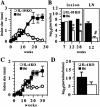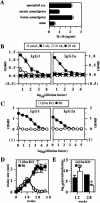Interleukin 10- and Fcgamma receptor-deficient mice resolve Leishmania mexicana lesions
- PMID: 15784551
- PMCID: PMC1087424
- DOI: 10.1128/IAI.73.4.2101-2108.2005
Interleukin 10- and Fcgamma receptor-deficient mice resolve Leishmania mexicana lesions
Abstract
Infection of C57BL/6 (B6) mice with Leishmania mexicana is associated with a minimal immune response and chronic disease. Here we show that B6 interleukin 10-/- (IL-10-/-) mice resolve their lesions and exhibit increased gamma interferon (IFN-gamma), nitric oxide production, and delayed-type hypersensitivity. This enhanced resistance was dependent upon IL-12p40, since treatment of L. mexicana-infected IL-10-/- mice with anti-IL-12p40 monoclonal antibody abrogated healing. Antibody-opsonized L. mexicana induced IL-10 production by B6 macrophages in vitro, implicating antibody binding to Fc receptors as a mechanism involved in IL-10 production in this infection. Furthermore, B6 FcRgamma-/- mice resolve L. mexicana lesions, and lymph node cells from these mice produced less IL-10 and more IFN-gamma than cells from infected wild-type mice. These data demonstrate that removal of IL-10 or FcgammaR leads to resolution of L. mexicana disease and support a model in which ligation of FcgammaR by L. mexicana-bound immunoglobulin G promotes IL-10 production, leading to chronic disease.
Figures






References
-
- Alexander, J., F. Brombacher, H. A. McGachy, A. N. McKenzie, W. Walker, and K. C. Carter. 2002. An essential role for IL-13 in maintaining a non-healing response following Leishmania mexicana infection. Eur. J. Immunol. 32:2923-2933. - PubMed
-
- Alexander, J., G. H. Coombs, and J. C. Mottram. 1998. Leishmania mexicana cysteine proteinase-deficient mutants have attenuated virulence for mice and potentiate a Th1 response. J. Immunol. 161:6794-6801. - PubMed
Publication types
MeSH terms
Substances
Grants and funding
LinkOut - more resources
Full Text Sources
Molecular Biology Databases

